Hybrid travel trailers have become increasingly popular in recent years, probably because they offer some unique advantages. But what exactly is a hybrid camper?
In today’s post, we’re investigating the hybrid camper to find out what’s behind the growing popularity of these rigs, and what pros and cons should be weighed for anyone considering a hybrid.
Could a hybrid camper be just the rig you’ve been seeking for your family’s camping trips?
Let’s find out!
What’s a Hybrid Camper?
In general, a hybrid camper is part hard-sided RV and part pop-up trailer.
The manner in which the camper pops up or out depends on the model and floor plan.
With some hybrids, it’s the top that pops up. This can be an advantage because it allows for the trailer to be shorter and more aerodynamic when being towed while having the ability to expand in size once you’ve arrived at your camping location. The expansion generally offers more headroom and/or extra sleeping space.
In other hybrids, the sides pop out to expand the interior and offer more living and/or sleeping space.
Some hybrid campers even have slides built into the mix offering even more space in the living area.
The word “hybrid” implies a combination of two things, and in the case of hybrid campers, the combination is that of a hard-sided travel trailer and soft-sided pop-up-like expansions.
What Are the Pros and Cons of a Hybrid Camper?
As with anything else, hybrid campers have advantages and disadvantages when compared with other types of RVs.
Let’s take a quick look at the pros and cons of hybrid campers.
Advantages of Hybrid Campers
There are some definite advantages to consider where hybrid campers are concerned, so let’s take a look at the pros first.
Pop-Up/Pop-Out Sections Allow Fresh Air Into the Camper
The screened canvas pop-up or pop-out sections allow for fresh air to flow into and through the camper.
This can be a welcome advantage in good weather, especially at night.
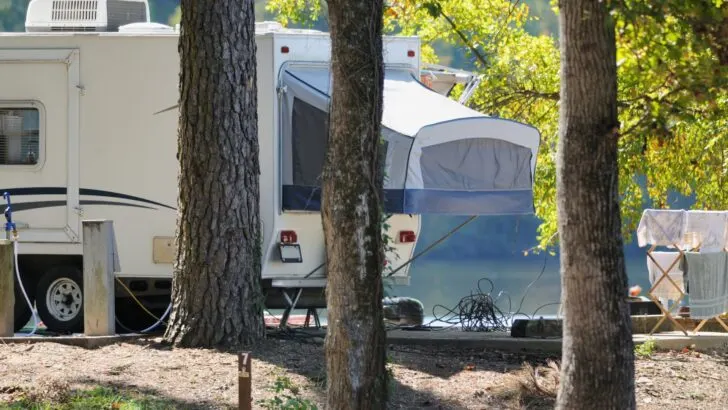
The pop-out of a hybrid camper is screened on three sides offering a flow of fresh air into the space.
Smaller Footprint – Same Capacity
Hybrid campers have a smaller overall footprint, but once the pop-up or pop-out sections have been expanded, they can have living and sleeping capacities similar to much larger travel trailers.
Lighter Weight
For fairly obvious reasons, hybrid campers are lighter weight for their expanded size and capacity than hard-sided campers.
The unloaded vehicle weight (the weight of the camper as it comes from the factory) of a hybrid camper is often less than that of a hard-sided travel trailer of the same capacity due to the lighter weight of the materials used to expand a hybrid.
This makes them easier to tow using smaller tow vehicles such as mid-sized SUVs or minivans.
Note that the unloaded vehicle weight (UVW) is quite different from the gross vehicle weight rating. GVWR reflects the weight of the fully loaded RV including cargo, fluids in all tanks, passengers, and any optional equipment. This needs to be taken into consideration when determining how much a vehicle can tow.
Lower Fuel Consumption to Tow
The smaller footprint and lower weight of a hybrid camper mean that towing one will consume less fuel than towing a similar-sized hard-sided travel trailer of the same sleeping/living capacity.
Less Expensive
Overall, a hybrid camper is less expensive to buy than an equivalent-size hard-sided camper with similar amenities and features.
If you look at cost per square foot, in fact, most hybrid campers cost far less than a hard-sided camper of the same size and capacity.
Disadvantages of Hybrid Campers
Besides the pros, there are some cons to consider when you’re determining whether a hybrid camper is right for you. Depending on how and where you travel and camp, the disadvantages could outweigh the advantages.
Let’s take a look…
Not as Well Insulated
Hybrid campers tend to be less well insulated, so they may not be useable in as many seasons as a hard-sided travel trailer.
Depending on when and where you travel, for example, winter camping in a hybrid camper might not be a good option in winter or even late fall.
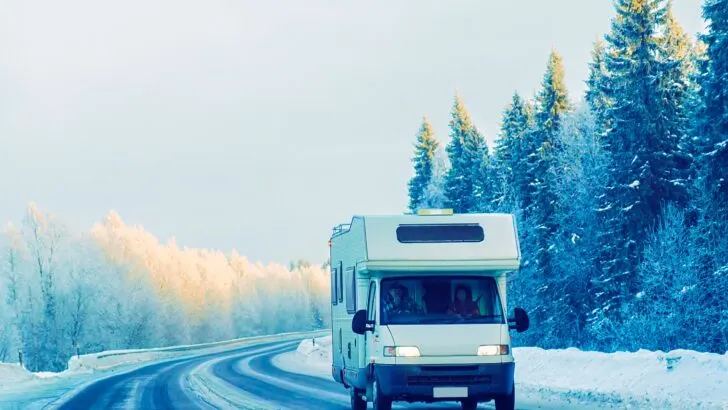
If you enjoy traveling and camping year-round including in areas where it can be cold and snowy, a hybrid camper might not be the best option for you as they’re not as well insulated as hard-sided rigs.
Canvas Sections Could Leak
The canvas sections of hybrid campers are more prone to leaking than typical hard sides on a camper are.
While most are fairly well-made, all can certainly allow water into the camper when the top or sides are popped open. Some can even lose their integrity over time allowing leakage when closed.
The latter may be rare, but it’s a possibility. The former could happen anytime the canvas sections are open.
Less Security with Canvas Sections
There’s obviously less security when the canvas sections of a camper are open.
This may or may not be a consideration for you depending on where you camp, but it’s certainly worth noting.
Canvas More Prone to Ripping
The canvas sections of a hybrid can tear or be otherwise damaged during use or over time.
This is something that wouldn’t be a concern with a hard-sided camper.
Inclement Weather May Require Drying of Canvas
If you get rained while you’re camping, you’ll want to dry the canvas out once you’ve returned home from your trip to prevent the growth of mold and mildew.
Depending on the extent of the rain exposure, this could require a fair amount of time in direct sunlight.
5 Hybrid Campers to Investigate
Following are five hybrid campers of varying capacities and prices to give you an idea of what a hybrid camper has to offer.
Palomino Solaire Expandable Ultra Lite 244H
From Palomino (a division of Forest River) comes the Solaire Ultra Lite 244H Expandable travel trailer.
This hybrid travel trailer is new for 2023 and detailed specs are unavailable at the time of this writing.
However, we’re including the Solaire Expandable 244H because it’s a good model for illustrating the vast expandability of a hybrid camper with its three popout sleeping quarters, all with 60″ x 80″ (queen size) beds.
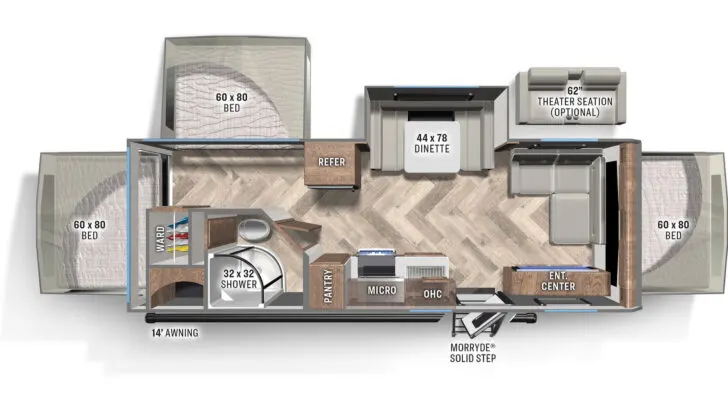
This floor plan illustrates how a hybrid camper can make the most of the interior space of the travel trailer while providing plenty of space for sleeping quarters using popouts. (Image credit: Palomino/Forest River)
The video below gives you an idea of the interior layout and how Palomino/Forest River has made use of the space (both interior and storage space).
Forest River Flagstaff Shamrock 19
Forest River has introduced its Flagstaff Shamrock Expandable Hybrid Travel Trailer line. There are several models and floor plans from which to choose, all of which offer the classic expandability of a hybrid camper.
The Flagstaff Shamrock 19 has expandable pop-outs in the front and the rear of the camper, making it possible to sleep 4 to 6 people in this 22-foot travel trailer.
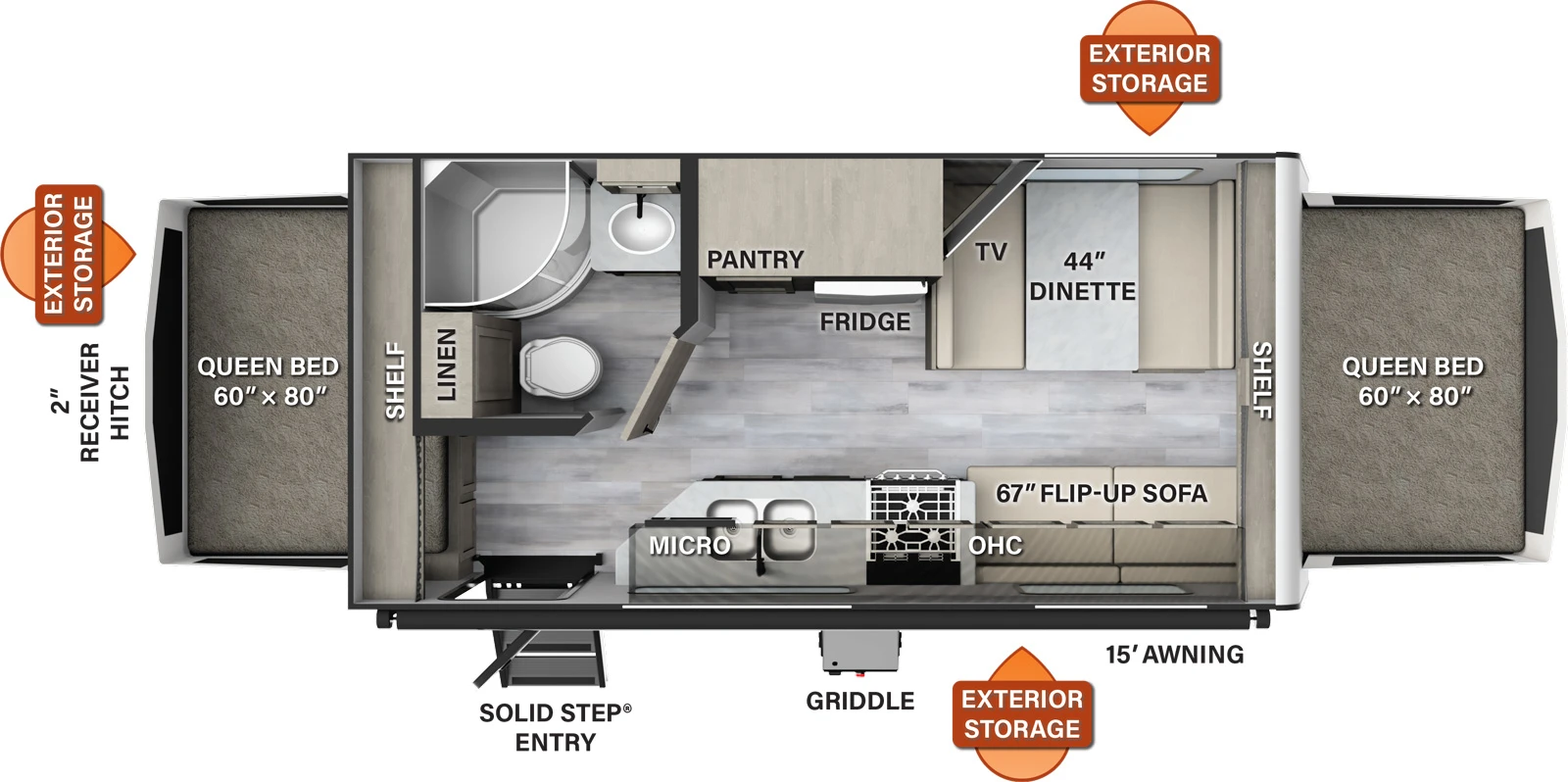
The Forest River Flagstaff Shamrock 19 is only 22′ long and yet its sleeping capacity is significant thanks to the expandability of this hybrid camper. (Image credit: Forest River)
The UVW (unloaded vehicle weight) of this hybrid travel trailer is 4,298 lbs. It has a 54-gallon freshwater tank, (considerable water capacity in a 22-foot rig), and 30-gallon gray and black water tanks.
Here’s a video tour of the 2023 Shamrock 19:
Forest River Rockwood Roo
The Forest River Rockwood Roo series of expandable travel trailers are available in five different floorplans from 21′ 2″ (4,259 lb. UVW) to 24′ 10″ (5,639 lb. UVW).
All of the floorplans of the Rockwood Roo line of hybrid campers carry a 54-gallon fresh water tank and 30-gallon black and gray water tanks.
The Rockwood Roo expandable travel trailer with the largest sleeping capacity is the 233S with its three pop-outs with queen-size beds, slide-out with convertible dinette, and flip-up sofa, allowing sufficient room to sleep up to 10 people!
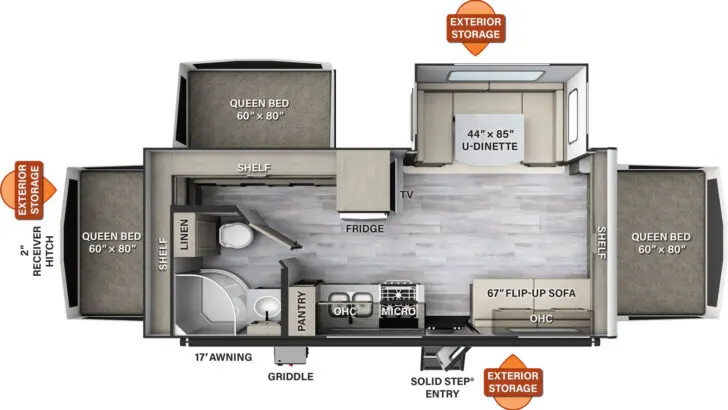
Forest River’s Rockwood Roo line includes the 233S with a slide-out and three pop-outs. (Image credit: Forest River)
Here’s a video walk-through of the 233S:
Jayco Jay Feather X19H
Jayco’s Jay Feather X19H is a 20′ 10″ hybrid travel trailer with a UVW of only 3,910 lbs. making it easy to tow with some smaller vehicles such as some SUVs and mid-size pickup trucks.
The X19H has two popouts, one on each end of the camper. The front popout houses a 60″ x 76″ bed and the rear one holds a 58″ x 76″ bed. It also has a convertible dinette and a jackknife sofa, allowing this lightweight little hybrid to sleep up to 8 people.
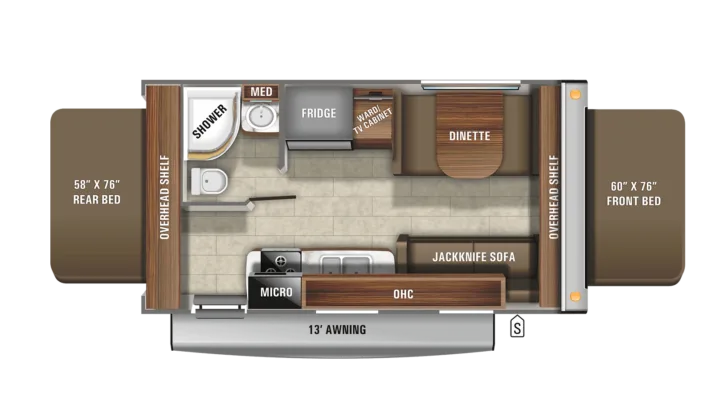
The Jayco Jay Feather is less than 22 feet long and very lightweight, but it has the capacity to sleep up to 8 people. (Image credit: Jayco)
The Jay Feather has a 48-gallon fresh water tank, a 30.5-gallon gray water tank, a 22-gallon black water tank, and a 40-gallon propane tank.
Black Series HQ14
This is the Black Series HQ14 hybrid travel trailer.
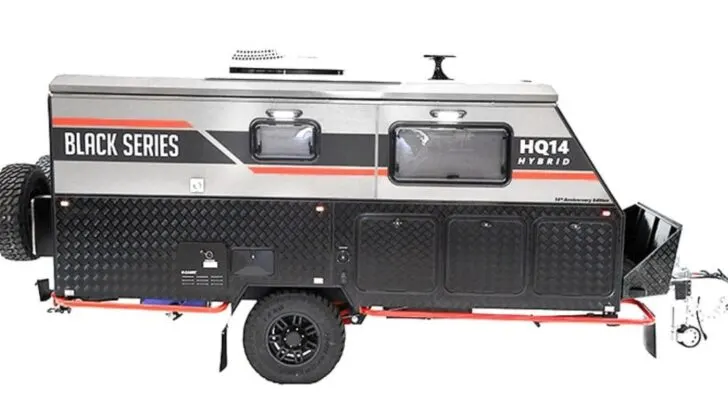
The Black Series HQ14 hybrid camper pops UP (as opposed to out), granting more headroom to its occupants. (Image credit: Black Series)
You may recall our post on our tour of the Black Series Camper facility in City of Industry, California in March, 2022. We weren’t expecting to be quite so blown away, but we were. These things really are the “Swiss Army knife” of campers. And rugged? You almost have to see them to believe them.
Black Series campers are incredibly well-constructed and have the ability to travel off-road…and by “off-road”, we mean they were conceived, designed, and tested with the unforgiving terrain of the Australian Outback in mind.
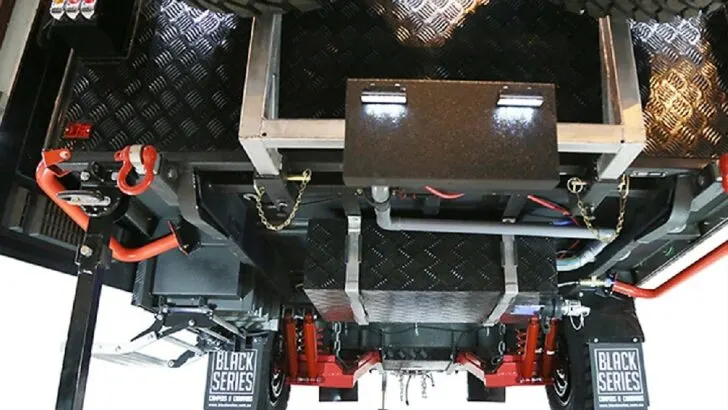
The ultra-rugged construction of Black Series campers makes them ideal for traveling off-road to remote locations. (Image credit: Black Series)
The HQ14 has a one-piece aluminum roof and there’s R16 spray foam insulation on the roof and walls.
Unlike the others on our list, the HQ14 pops UP instead of out, giving more headroom to the 19.8′ rig.
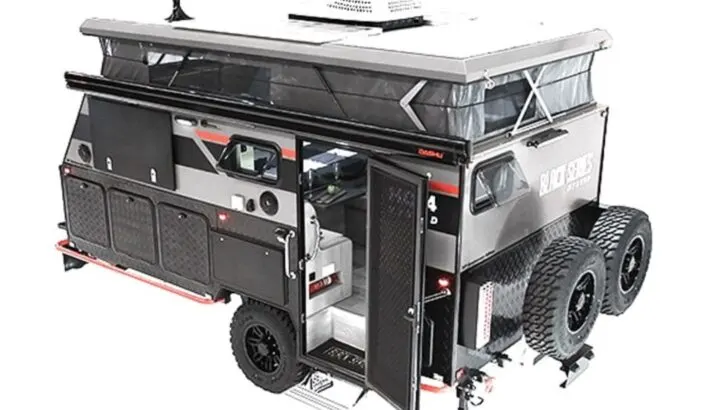
A glimpse of the Black Series HQ14 hybrid camper with the top popped up. (Image credit: Black Series)
With a dry weight of 4,376 pounds, this camper is one of Black Series’ smallest, lightest options.
We should note that the HQ12 is only slightly heavier at 4,422 lbs dry weight and only slightly shorter at 19.6″, but it has the capacity to sleep 4 people as opposed to the sleep limit of 2 (one queen-size bed) for the HQ14.
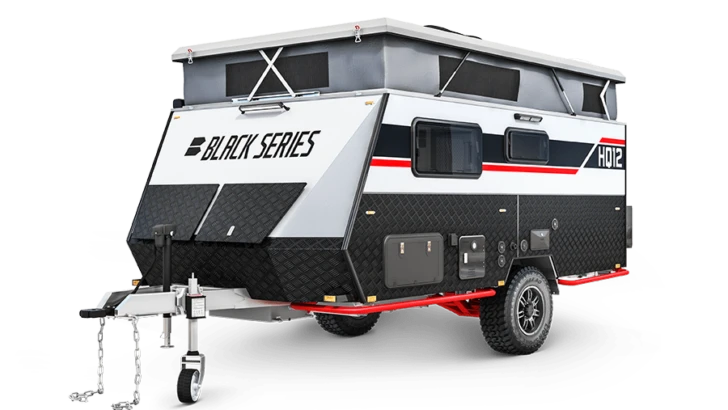
The Black Series HQ12 camper is very close in length to the HQ14 hybrid, but the HQ12 can sleep 4 people while the HQ14 has only the one queen-size bed. (Image credit: Black Series Campers)
The HQ14 has a 2-stage pop top with a fold-out bed extension enclosure. It has indoor and outdoor showers. Tank capacities include a 26-gallon fresh water tank and a 42-gallon gray water tank.
The HQ14 hybrid camper from Black Series comes with two 150W solar panels and two 100AH batteries.
What Are Your Thoughts on Hybrid Campers?
Hopefully, we’ve given you a general idea of what a hybrid camper has to offer and its most unique feature, expandability.
The fact that these rigs have a smaller, lighter footprint but offer expanded living quarters upon arrival at a campsite is what draws most hybrid buyers.
Let us know what you think of hybrid campers. Do the pros outweigh the cons from your perspective? Do you own one? Drop us a comment below!
In the market for a truck to tow your new hybrid camper? Read about The Best Half Ton Trucks For Towing an RV Safely & Securely!
Geek Out with Us Every Week
Join our newsletter to learn about all things RV-related. Every week we offer free tips, tricks, product reviews, and more to our online community of RVers. So, whether this is your first time on the road or you’re a seasoned expert, we’d love for you to geek out with us!


Michelle
Sunday 3rd of December 2023
We have a 2018 Rockwood Roo 24ws. We have 2 queen fold down beds, a table that makes into a bed, and a sleeper sofa. When it's just my husband and I, we leave the beds up and sleep on the sleeper sofa. We've added additional foam and pillow top covers which makes it really comfortable to sleep on - even more so than the beds. Our sofa and table are on a slide out, as well as a wardrobe closet that holds all of our clothing so we don't need luggage. Lots of counter space and storage. Absolutely love it!
Jane Melvin
Thursday 7th of September 2023
what is the benefit of dual axle versus single axle for hauling with a larger SUV? How does dual affect the weight? We are interested in a hybrid.
TheRVgeeks
Saturday 9th of September 2023
Hi Jane. Usually, the presence of single or dual axle is determined by the gross vehicle weight rating (GVWR) of the trailer... as trailers get heavier, they need more axles to spread the weight evenly. So it's not usually something that you can decide on with a particular trailer... it either comes with single or dual.
That said, typically the biggest benefit you'll get from a dual axle setup is an improvement in stability when towing. Dual axles will help the trailer to track better and helps to resist sway. But, dual axle trailers are heavier (usually by default... since the weight is typically the reason for the second axle), more expensive (bigger/heavier = more cost... plus more tires means more maintenance cost), and have a wider turning radius.
There's a good breakdown on the pros/cons of single -vs- dual axle trailers from TAXA here: https://taxaoutdoors.com/blogs/articles/double-axle-vs-single-axle-trailers
Ronald Dinkel
Tuesday 13th of December 2022
I have a Jayco 2004 23B and love it. My question is why are not bigger ones made? The weight and concept are great for us with half ton trucks.
TheRVgeeks
Tuesday 13th of December 2022
Hi Ronald! Good question. Likely it has to do with the intended purpose of these Hybrid RVs... to be lighter and more aerodynamic so they can be pulled with smaller, less powerful vehicles. So we suppose making bigger ones would go against that design ethic. Given time, though... demand may dictate that they consider just what you want!
George Taylor
Saturday 3rd of December 2022
We have a Conqueror490 off road hybrid. We so love the expansion of the foldout for additional sleepers and head room. Combined with the outdoor Kitchen / Table, Shower and nearly 360 degrees of batwing coverage it is the "Swiss Army Knife" and always gets attention in the campgrounds. Truly Amazing and flexible experience based on how long you're staying and how many people you have. If its just the wife and I we can easily pull into the spot late at night and be in bed in less than 5 minutes.
TheRVgeeks
Saturday 3rd of December 2022
That's awesome, George! Great to hear yet more validation for these wonderful campers!
Ed Fogle
Saturday 3rd of December 2022
We went from a pop-up to a hybrid for a variety of reasons. We didn’t want to lose the sense of tent camping and ventilation of the beds of the pop-up. However, we wanted the ability to stop and go into the trailer for lunch, use the toilet or a quick night’s sleep. We can sleep in the dinette without opening the beds. This also works if it’s too cold to sleep in the pop-out beds. Hybrids take less time to set up than pop-ups. The toilet is permanently set up, also, unlike a pop-up. Basically you get the advantages of a travel trailer while keeping the camping sense of a Pop-up.
Jane Melvin
Thursday 7th of September 2023
@Ed Fogle, that is really helpful, Ed. We are in the same situation and are now in our early 70's, so putting up the popup will also be a factor down the pike. But we love tenting and your post really nailed the positive side of it.
TheRVgeeks
Saturday 3rd of December 2022
That’s awesome, Ed! Thanks so much for providing first-hand verification of the versatility of these wonderful RVs.